Change of Base Formula or Rule
I have discussed most of the log rules in a separate lesson. However, I have intentionally left one out to discuss it here in detail. This log rule is called the Change-of-Base Formula.
If you are interested in seeing how the Change-of-Formula works, please click on the following link: Proofs of Logarithm Properties.
The logarithm that is using base-[latex]10[/latex] is known as the common logarithm, while the one using base-[latex]e[/latex] is known as the natural logarithm.
The Number [latex]\Large{\color{black}{e}}[/latex]
Note: The number [latex]e[/latex] is a mathematical constant which has a numerical value of [latex]e \approx 2.71828[/latex]. It is an irrational number because it cannot be expressed as a ratio of two integers or as a fraction. More so, the number [latex]e[/latex] is the base of the natural logarithm.
Therefore, the common logarithms and natural logarithms are utilizing the standard bases [latex]10[/latex] and [latex]e[/latex], respectively.
- common logarithm is written as [latex]\large{\color{red}\log x = {\log _{10}}x}[/latex]
- natural logarithm is written as [latex]\large{\color{blue}\ln x = {\log _e}x}[/latex]
Before we continue, I would like to point out some nuances or subtleties with regard to the mathematical expressions of common and natural logarithms.
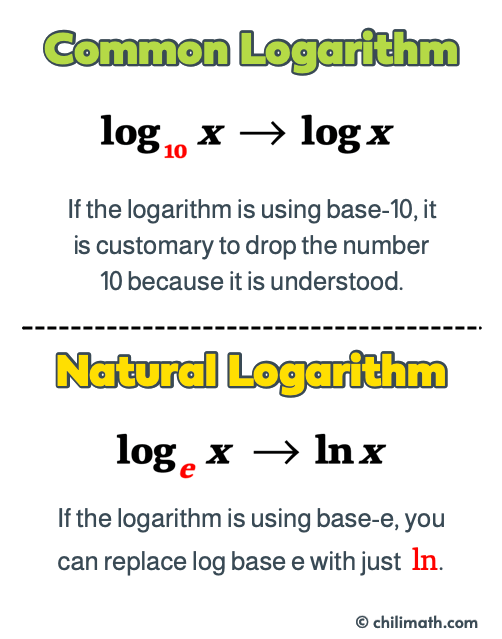
The LOG and LN Buttons of a Graphing Calculator
Most graphing calculators have functions or keys that directly calculate the logarithms of numbers in base-[latex]10[/latex] and base-[latex]e[/latex]. Thus, you will only see two buttons: LOG for common logarithm and LN for natural logarithm.
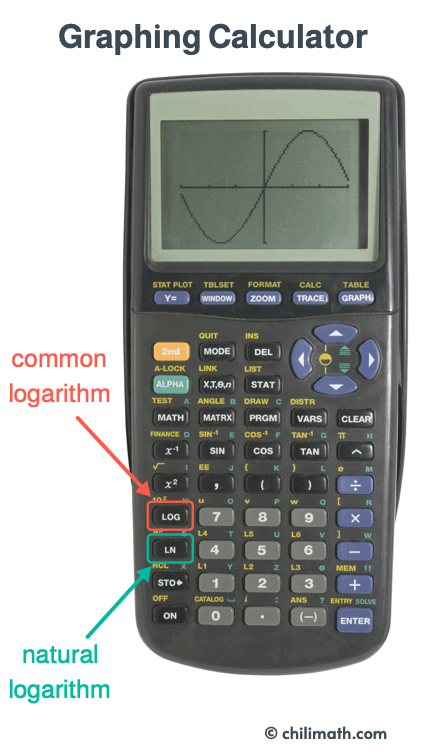
It is obvious that a problem arises when we want to calculate the logarithm of a number using non-standard bases such [latex]2[/latex], [latex]3[/latex], [latex]7[/latex], [latex]0.5[/latex], and [latex]0.25[/latex].
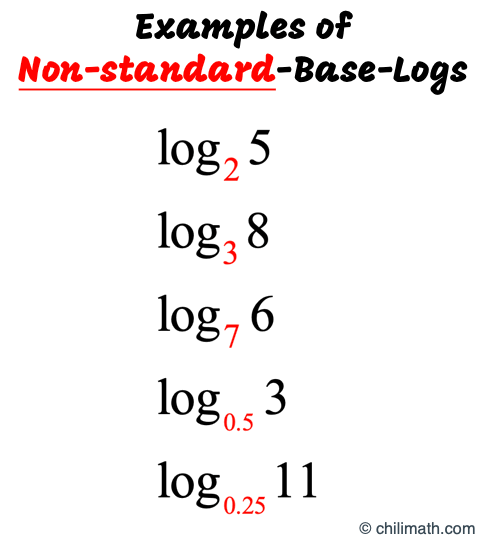
The logarithms above use NON-STANDARD bases because they are neither [latex]\large{\color{green}10}[/latex] nor the number [latex]\large{\color{green}e}[/latex].
How do we proceed to punch in the numbers on a graphing calculator? As I mentioned before, most calculators are limited to only compute logarithms with base 10 and base e.

This is where the Change-of-Base Formula comes to rescue. It can convert a non-standard-base logarithm as a ratio of two logarithmic operations that use the standard base either [latex]10[/latex] or the constant [latex]e[/latex].
What is the Change-of-Base Formula?
The Change-of-Base Formula is an instruction on how to rewrite or transform a given logarithmic expression as a ratio or fraction of two logarithm operations using any valid base.
That means, if we have a logarithm using a specific base, then we can turn this into an equivalent ratio or fraction of two logarithmic operations such that we can pick any base that we want. We can literally select any base as long as it is positive but not equal to [latex]\color{red}1[/latex].
But if we want to calculate or know the value of a logarithm, we should pick base-10 or base-[latex]e[/latex] since most calculators have these function keys. The log key [log] computes the common (using base-10) logarithm while the ln key [ln] calculates the natural (using base-[latex]e[/latex]) logarithm.
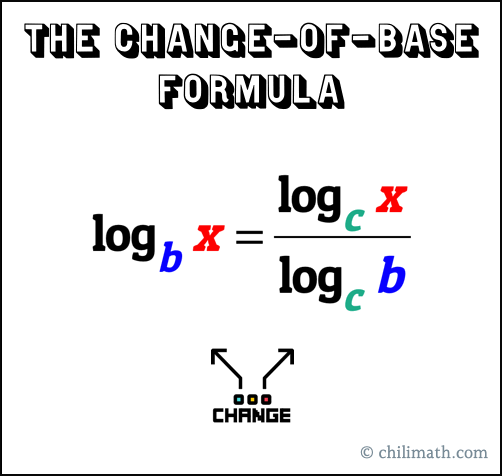
Let’s parse how the formula transformed the original logarithm into an equivalent expression as a ratio of two log operations.
- The argument of the original logarithm becomes the argument of the logarithm of the numerator.
![log base b of (x) = [log base c of (x)]/[log base c of (b)]](https://www.chilimath.com/wp-content/uploads/2020/04/numerator-of-change-of-base-formula.gif)
- The base of the original logarithm becomes the argument of the logarithm of the denominator.
![b in log base b of (x) becomes the logarithm argument of the denominator which is [log base c of (b)]](https://www.chilimath.com/wp-content/uploads/2020/04/denominator-of-change-of-base-formula.gif)
- The logarithms in the numerator and denominator have the same base. The value of the base [latex]\large\color{green}c[/latex] is any base that we chose.
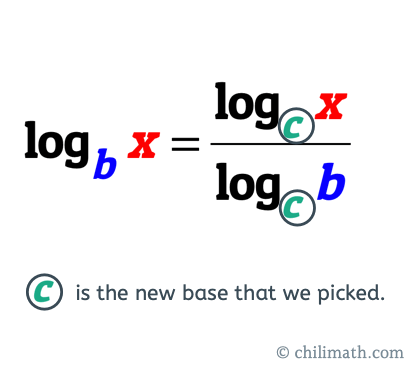
Examples of the Change-of-Base Formula
The first two examples (Example #1 and #2) are perfect textbook problems because the argument and the base of a logarithm can be expressed as powers of a common number (a positive number that is not equal to 1) which serves as the new base when applying the change-of-base rule.
Example 1: Evaluate [latex]\large{\log {}_48}[/latex].
The first thing I recognized is that both the argument and its base can be expressed as a power of [latex]2[/latex].
Notice that
- [latex]8 = {2^3}[/latex]
- [latex]4 = {2^2}[/latex]
Therefore, it just makes sense to transform [latex]\log {}_48[/latex] as a ratio of two logarithmic operations with base-[latex]2[/latex] using the Change-of-Base Formula. Then simplify further using the following rules of logarithms which are:
- [latex]\large{\color{blue}{\log _b}\left( {{x^k}} \right) = k \cdot {\log _b}\left( x \right)}[/latex]
- [latex]\large{\color{red}{\log _b}b = 1}[/latex]
Here is the complete solution.
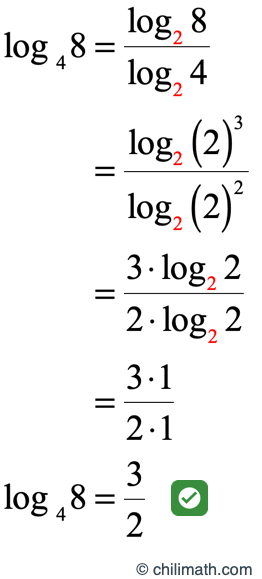
Example 2: Evaluate [latex]\large{\log {}_{\large{{1 \over {27}}}}\left( 9 \right)}[/latex].
You might think that there’s a problem with the question because the base of the logarithm is a fraction. Remember that the base of a logarithm must be positive but it cannot equal [latex]1[/latex]. So, the base [latex]\large{1 \over {27}}[/latex] is perfectly okay. It is obviously a positive number and it doesn’t equal [latex]1[/latex].
The fraction [latex]\large{1 \over {27}}[/latex] can be re-written a power of [latex]3[/latex]. This is where the Negative Rule of Exponent comes in handy.
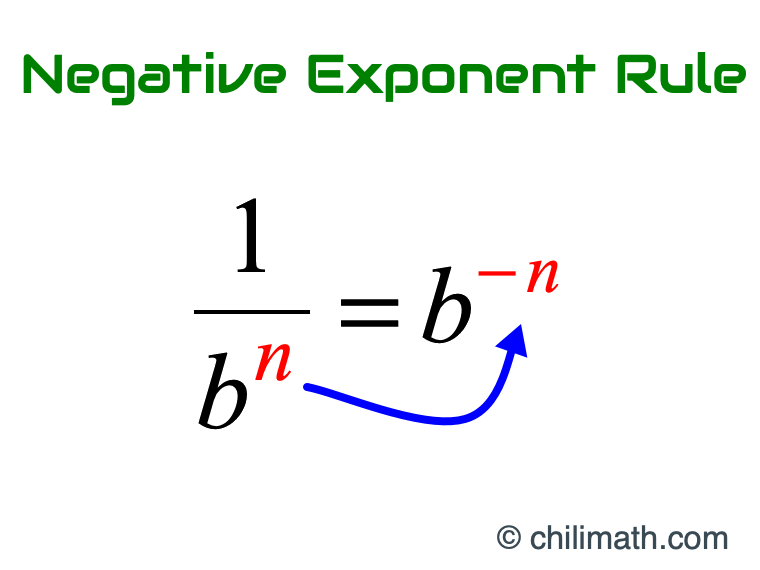
The Negative Rule of Exponent allows us to invert the fraction (reciprocal) but we must switch the sign of the exponent.
For [latex]\Large{{1 \over {27}}}[/latex], we can express it as a power of [latex]3[/latex] with a negative exponent.
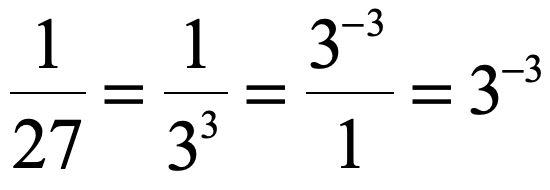
For [latex]9[/latex], we can also rewrite it as a power of [latex]3[/latex] which is [latex]9 = {3^2}[/latex].
Since the base and argument of [latex]\large{\log {}_{{1 \over {27}}}\left( 9 \right)}[/latex] can be rewritten as powers of [latex]3[/latex], we will be calculating this logarithm using the Change-of-Base Formula with base-[latex]3[/latex].
On top of the Negative Rule of Exponent, we will also need the rules of logarithms as shown below.
- [latex]\large{\color{blue}{\log _b}\left( {{x^k}} \right) = k \cdot {\log _b}\left( x \right)}[/latex]
- [latex]\large{\color{red}{\log _b}b = 1}[/latex]
Now, below is the complete solution.
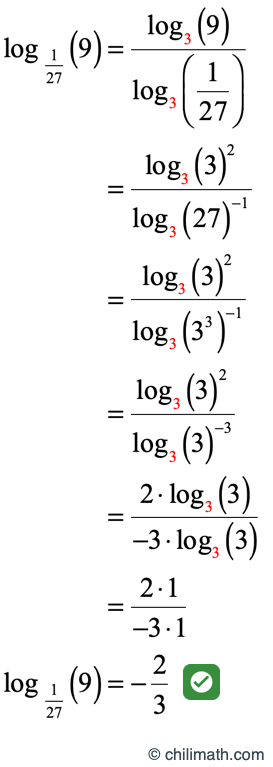
Example 3: Calculate the value of [latex]\large{\log {}_{\large{5}}\left( {12} \right)}[/latex]. Round your answer to the nearest thousandth.
This is no longer a “nice” problem because the argument and the base of the logarithm cannot be expressed as the powers of a common number. In other words, there is no scenario where we can express [latex]5[/latex] and [latex]12[/latex] as exponential numbers such that they have the same base.
To solve this, we can use the change-of-base rule to rewrite the original logarithm as a ratio of two logarithms of the base of our choosing. We have two options: use base-[latex]10[/latex] or base-[latex]e[/latex]. It doesn’t matter which one we choose because the answer will be the same. For this problem, let’s use base-[latex]10[/latex].
Don’t forget to round your answer to three decimal places because we are asked to round it to the nearest thousandth.
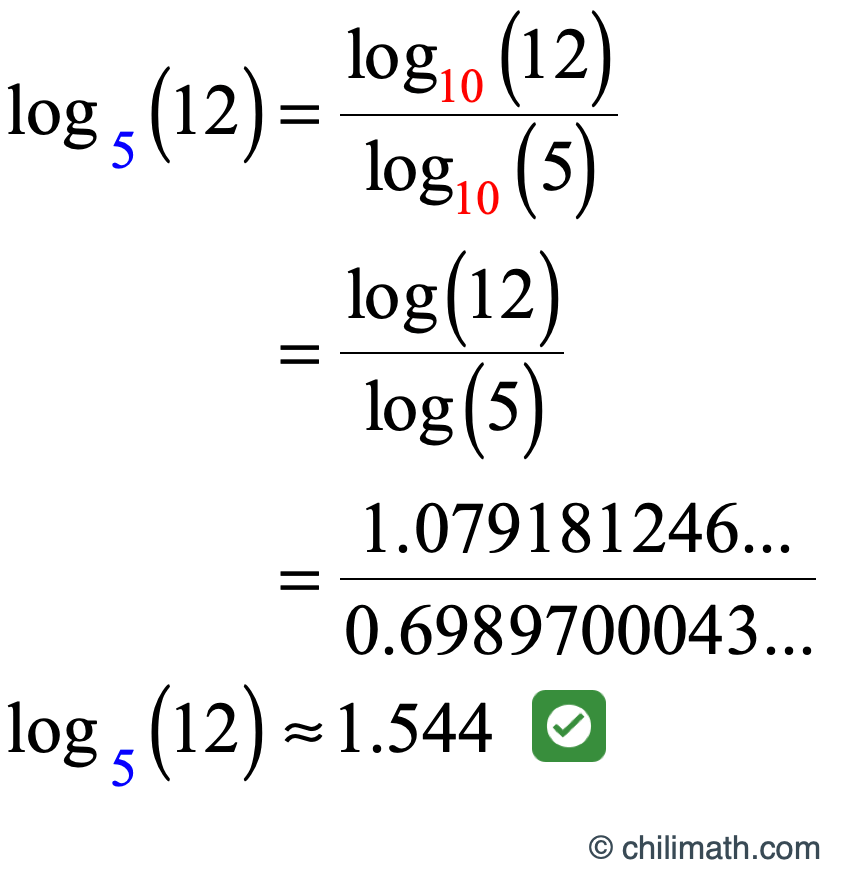
Our calculator should confirm that our answer is correct.
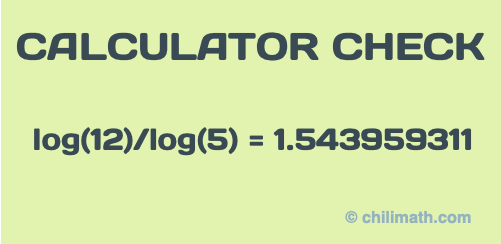
Example 4: Calculate the value of [latex]\large{\log {}_{\large{7}}\left( {9} \right)}[/latex]. Round your answer to the nearest hundredth.
In the previous example, we used base-[latex]10[/latex] to evaluate the logarithm. This time we will use the natural number [latex]\color{red}e[/latex] as the base of choice when applying the Change-of-Base formula.
Notice that we don’t need to write the natural logarithm as [latex]\large{{{\log }_e}\left( x \right)}[/latex]. We can omit that step and write it immediately as [latex]\large{\ln \left( x \right)}[/latex]. I added it as one of the steps below for clarity and emphasis purposes.
Let’s go ahead and apply the change-of-base rule to convert [latex]\large{\log {}_7\left( 9 \right)}[/latex] as a ratio or fraction of two natural log operations.
Also, make sure to round your answer to two decimal places since the problem requires us to express our final answer in the nearest hundredth.
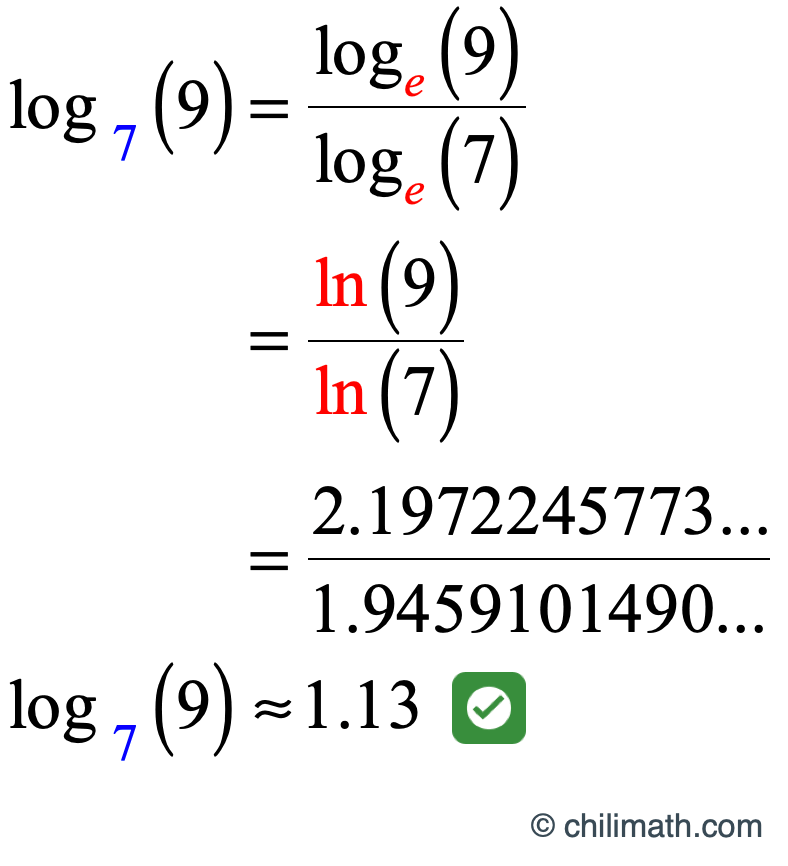
Your calculator should output a similar result just like the one below.
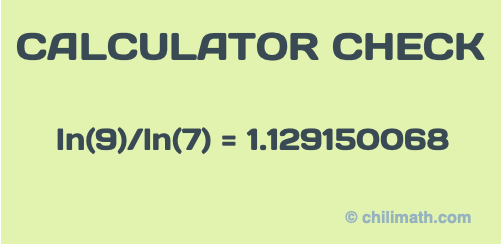
Example 5: Change [latex]\large{\log {}_{\large{6}}\left( {0.1} \right)}[/latex] as a quotient of two natural logarithms. Calculate its value then round to the nearest tenth.
This problem requires us to change the given logarithm as a quotient of natural logarithms. That means we have no choice but to use the natural number [latex]\large\color{red}e[/latex] as the base when we apply the change-of-base formula. Don’t forget as well that we are told to round our answer to the nearest tenth (one decimal place).
Here’s our solution:
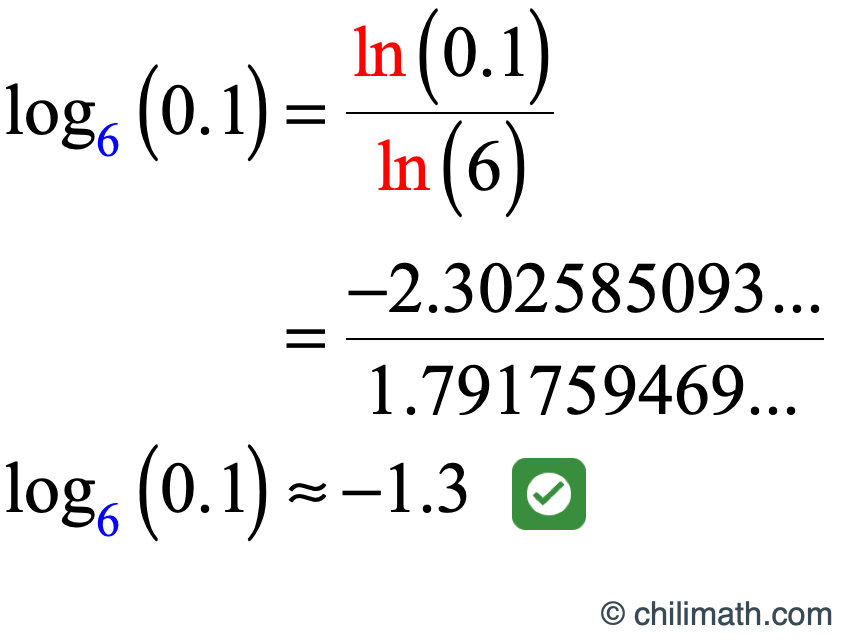
Our calculator agrees with our answer.
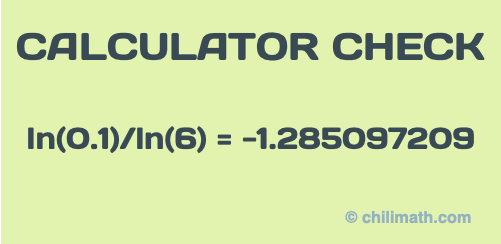
Example 6: Change [latex]\color{blue}\large{\log \left( 7 \right)}[/latex] as a quotient in terms of natural logarithms. Then compute its value. Round your answer to the nearest ten-thousandth.
I admit that although we can directly solve for the value of [latex]\color{red}\log \left( 7 \right)[/latex] with a calculator since it has a LOG key, this problem wants us to take the long route. Not because it is a futile exercise of our time but more importantly, it is an opportunity for us to apply our solid grasp or understanding of the change-of-base formula.
Remember that when you see a log operation without a base, it is assumed to have a base of [latex]10[/latex]. Therefore, our very first step is to rewrite [latex]\log \left( 7 \right)[/latex] as [latex]{\log _{10}}\left( 7 \right)[/latex] so that it is much easier to see what are the numbers we are dealing with during the change-of-base step.
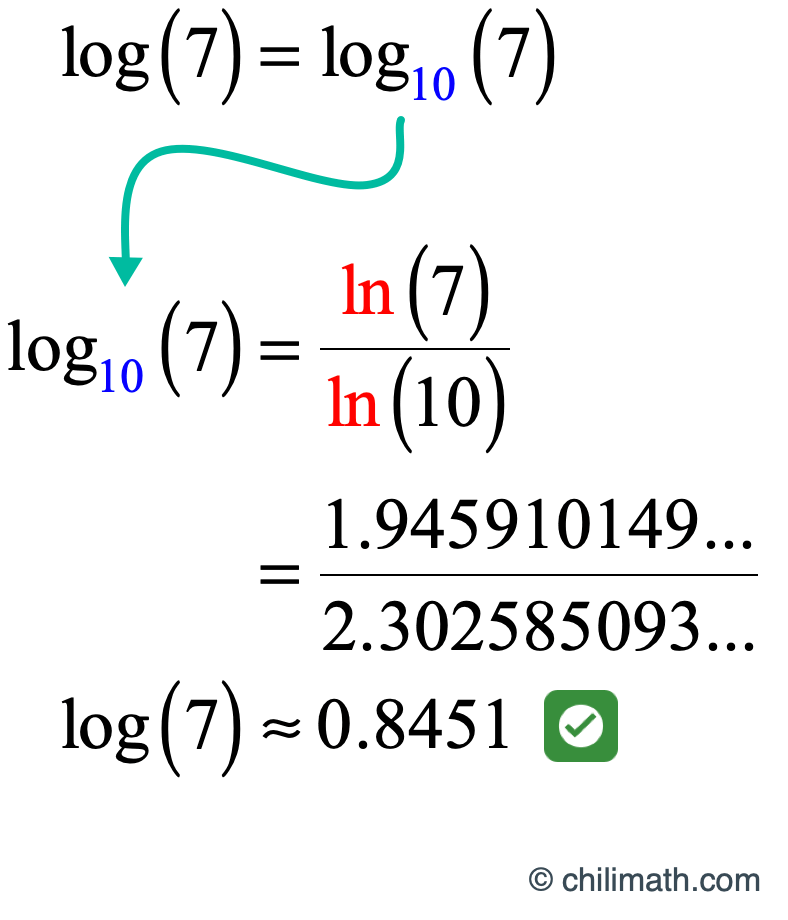
It’s a great feeling when a calculator outputs the value that verifies our answer.
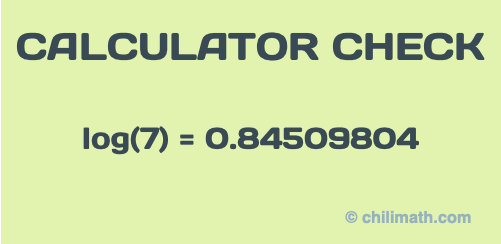
Example 7: Change [latex]\color{blue}\large\ln \left( {13} \right)[/latex] as a ratio in terms of common logarithms. Then calculate its value. Round your answer to the nearest ten-thousandth.
Just like example #6, there’s no need to apply the change-of-base formula because we can directly compute it with a calculator. However, the intention of this problem is to showcase our in-depth understanding of common and natural logarithms, and how to properly handle the formula.
So, let’s transform [latex]\large\ln \left( {13} \right)[/latex] in LOG form where the base is [latex]\large\color{blue}e[/latex], thus, [latex]\large{\log _{\large{e}}}\left( {13} \right)[/latex]. Now, we use the change-of-base formula to express it as a ratio of two common logarithms. Remember, the common logarithm uses base-[latex]10[/latex].
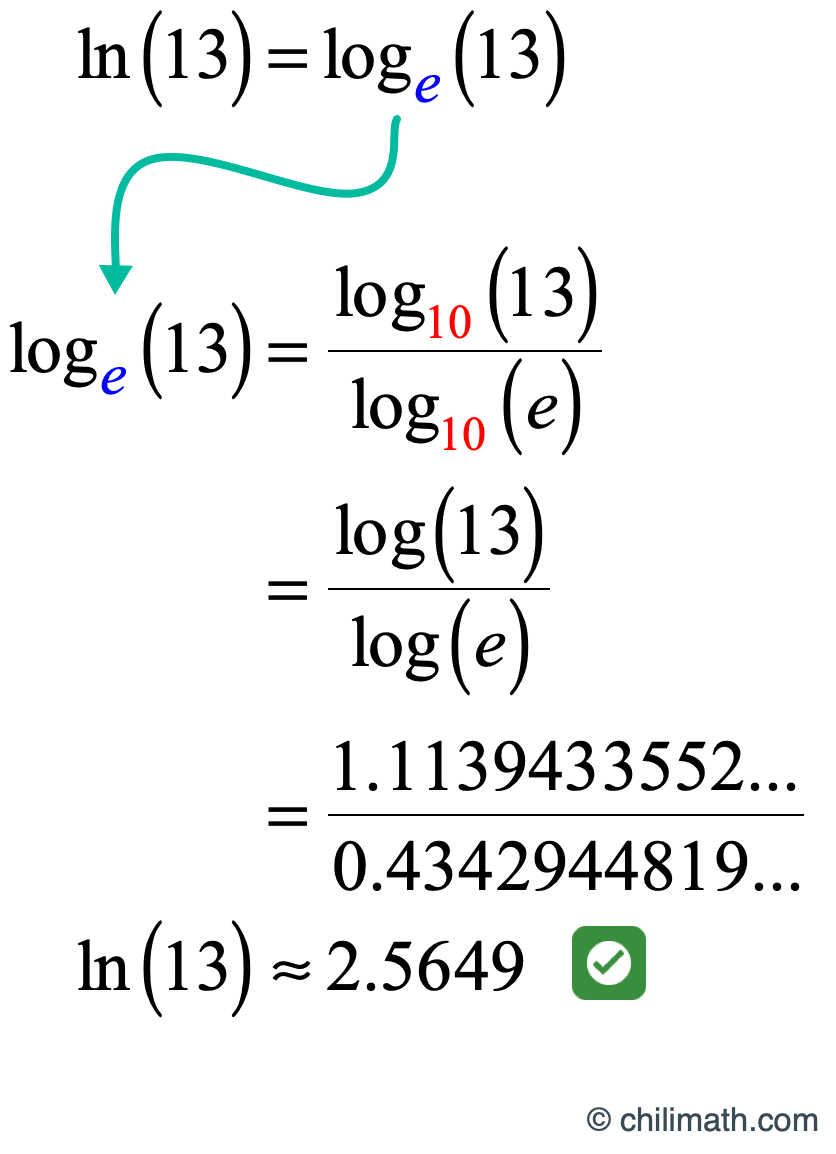
Yes! The calculator agrees with our answer.
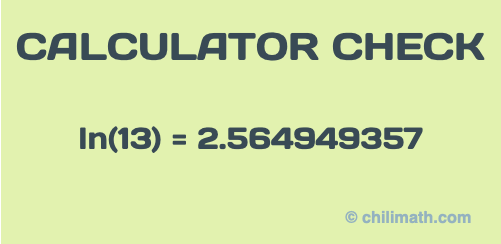
You may also be interested in these related math lessons or tutorials:

